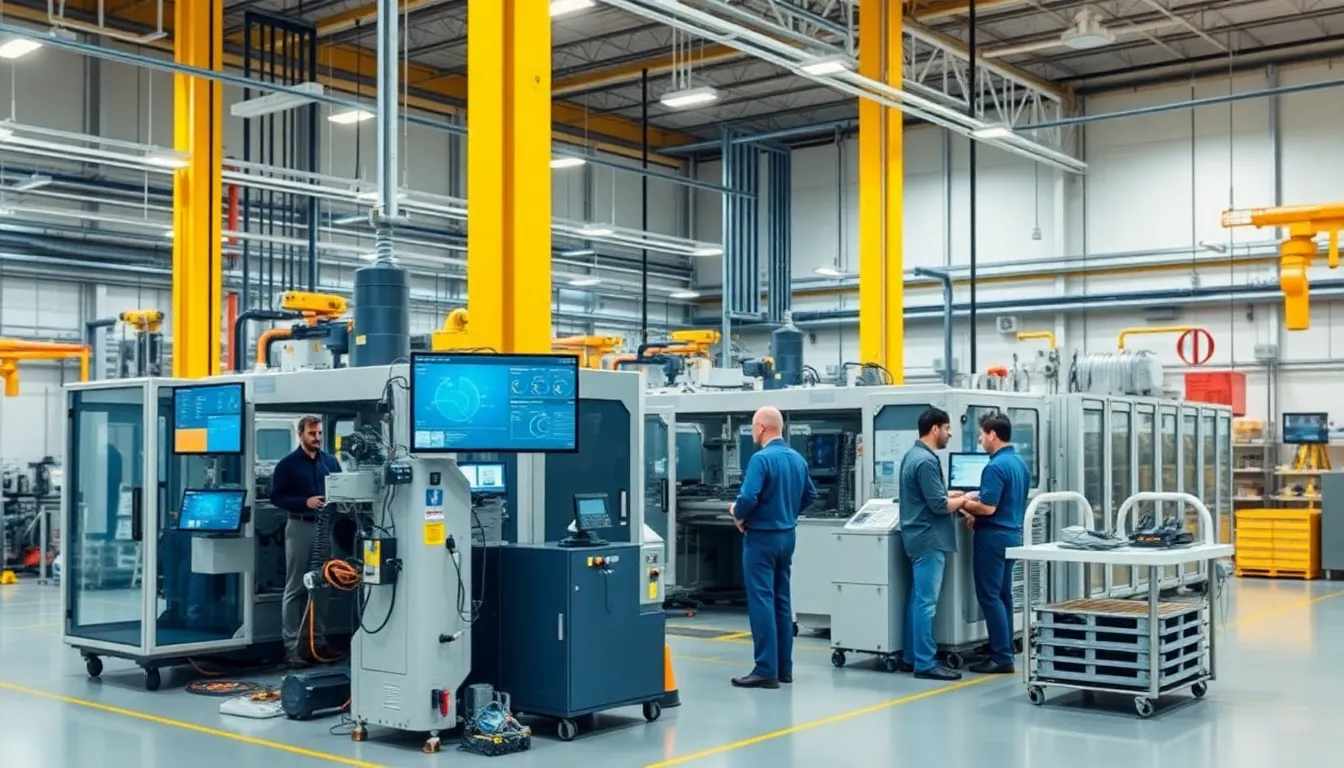In a world where factories are becoming as smart as your smartphone, the concept of smart factory networks is taking center stage. Imagine machines that not only talk to each other but also make decisions faster than you can say “production efficiency.” These networks are revolutionizing the manufacturing landscape, turning traditional factories into high-tech hubs of innovation.
Table of Contents
ToggleOverview of Smart Factory Networks
Smart factory networks represent a significant shift in the manufacturing landscape. These networks rely on interconnected machines equipped with advanced sensors and information technology. The integration of Internet of Things (IoT) devices facilitates real-time data exchange among machines and systems. Cloud computing enhances storage and analytical capabilities, enabling smarter operations.
Automation plays a crucial role in these environments. By leveraging artificial intelligence, machines optimize production processes independently. Operational costs decrease, as efficiency increases through data-driven decision-making. Moreover, predictive maintenance reduces downtime, enhancing overall productivity.
Collaboration among machines and systems strengthens adaptability. Factories can respond to market changes swiftly, aligning production with demand. Digital twins, or virtual replicas of physical assets, help in testing scenarios without disrupting actual operations. This ability supports continuous improvement initiatives.
Supply chain integration also benefits from smart factory networks. Enhanced visibility allows for better tracking of materials and products. Transparency in operations increases trust between stakeholders, fostering stronger relationships.
Data security remains essential in these networks. Protecting sensitive information from cyber threats is a priority. Robust cybersecurity measures safeguard manufacturing processes, ensuring operational continuity.
Ultimately, smart factory networks signify the future of manufacturing. Their capabilities transform traditional factories into agile, efficient, and connected environments. With continual advancements, the potential for innovation continues to expand, reshaping how industries operate.
Key Components of Smart Factory Networks

Smart factory networks depend on several key technologies that work together to enhance manufacturing capabilities. Understanding these components clarifies their impact on production efficiency.
Internet of Things (IoT)
IoT devices form the backbone of smart factory networks. These interconnected sensors and machines gather real-time data, enabling seamless communication across the production floor. Data from various sources helps operators monitor equipment performance, track materials, and adjust processes quickly. Enhanced connectivity fosters collaborative decision-making among machines and personnel, leading to improved efficiency. For instance, smart thermostats adjust heating based on machine operation schedules, optimizing energy consumption.
Big Data and Analytics
Big data plays a crucial role in transforming raw information into actionable insights. Analyzing vast amounts of data helps manufacturers identify patterns, predict equipment failures, and enhance production strategies. Advanced analytics tools streamline decision-making by providing real-time visualization of operational metrics. Companies make informed choices based on historical performance and market trends. With predictive analytics, they can optimize inventory levels, ensuring the right materials reach production lines at the right time.
Benefits of Implementing Smart Factory Networks
Smart factory networks offer numerous advantages that transform manufacturing processes. Their implementation leads to significant improvements in efficiency and flexibility.
Increased Efficiency
Smart factory networks enhance operational efficiency through automation and real-time data analysis. Advanced sensors gather data continuously, allowing immediate adjustments to production processes. Machines communicate autonomously, minimizing delays caused by human intervention. Predictive analytics also anticipate equipment failures, facilitating proactive maintenance. This approach reduces downtime considerably and boosts overall productivity. Manufacturers experience faster production cycles and optimized resource allocation, leading to lower operational costs. Efficiency gains can result in increased output, enabling companies to meet rising market demands effectively. By leveraging these technologies, factories achieve a seamless flow of operations that enhances performance across various departments.
Enhanced Flexibility
Flexibility arises as smart factory networks adapt to changing market conditions. Real-time data exchange allows manufacturers to respond promptly to consumer trends and preferences. The interconnected nature of machines enables rapid reconfiguration of production lines, accommodating varying product designs without significant downtime. Customization becomes more feasible, catering to specific customer needs. This agility supports a more versatile production strategy, ensuring that factories can pivot quickly in response to external factors. Improved collaboration among systems further enhances adaptability. Smart factories can align their outputs directly with demand fluctuations, maintaining optimal inventory levels and reducing excess stock. Such responsiveness allows manufacturers to thrive in a competitive landscape where change is constant.
Challenges in Smart Factory Networks
Smart factory networks face several challenges that can impact their effectiveness. Addressing these issues is critical for successful implementation and operational efficiency.
Security Concerns
Data security stands as a pivotal challenge within smart factory networks. Cyber threats expose sensitive information, making robust cybersecurity measures essential. Implementing encryption protocols and multi-factor authentication can significantly reduce risks. Additionally, regular security audits help identify vulnerabilities before they can be exploited. Manufacturers should prioritize training staff on cybersecurity best practices to foster a security-aware culture. Protecting intellectual property and operational continuity remains vital as the reliance on interconnected systems grows.
Integration Issues
Integration issues also complicate the adoption of smart factory networks. Diverse systems often use different standards, complicating communication and data exchange. Seamless interoperability among machines requires compatible software and hardware solutions. Organizations may face difficulties when retrofitting existing equipment or transitioning to modern systems. Planning for comprehensive integration can streamline these processes, enhancing overall productivity. Collaboration with vendors to ensure compatibility can help alleviate integration challenges as factories evolve into smarter environments.
Future Trends in Smart Factory Networks
Emerging trends highlight the ongoing evolution of smart factory networks. As technology progresses, factories will increasingly utilize advanced systems for optimization and sustainability.
AI and Machine Learning Applications
AI and machine learning significantly enhance smart factory networks. These technologies analyze vast amounts of data to predict maintenance needs, optimize production schedules, and improve quality control processes. Predictive analytics allows for proactive adjustments, which minimizes downtime and boosts overall productivity. Manufacturers leverage these insights to align production with consumer demand effectively, driving efficiency. In addition, real-time decision-making powered by AI can reduce waste and improve resource management. The integration of AI into operational frameworks is set to redefine manufacturing efficiency.
Sustainable Manufacturing Practices
Sustainable manufacturing practices emerge as a key focus within smart factory networks. Processes utilizing IoT devices and data analytics facilitate waste reduction and energy efficiency. Real-time monitoring of resource consumption enables manufacturers to identify and implement improvements. By adopting eco-friendly technologies, factories can minimize their environmental footprint while enhancing operational efficiency. Additionally, supply chain transparency fosters responsible sourcing and waste management, promoting trust among stakeholders. The commitment to sustainability not only benefits the environment but also appeals to consumers increasingly prioritizing eco-conscious products.
Smart factory networks are revolutionizing the manufacturing landscape by integrating advanced technologies that enhance efficiency and flexibility. As machines become more interconnected and capable of autonomous decision-making, manufacturers can respond swiftly to market demands and optimize production processes.
The emphasis on data-driven insights and predictive analytics drives continuous improvement while minimizing operational costs. However, addressing data security and integration challenges remains crucial for success.
With a focus on sustainability and innovation, smart factory networks are not just a trend but a necessary evolution in manufacturing. As industries embrace these changes, the potential for enhanced productivity and responsible practices will continue to grow, shaping the future of manufacturing.





